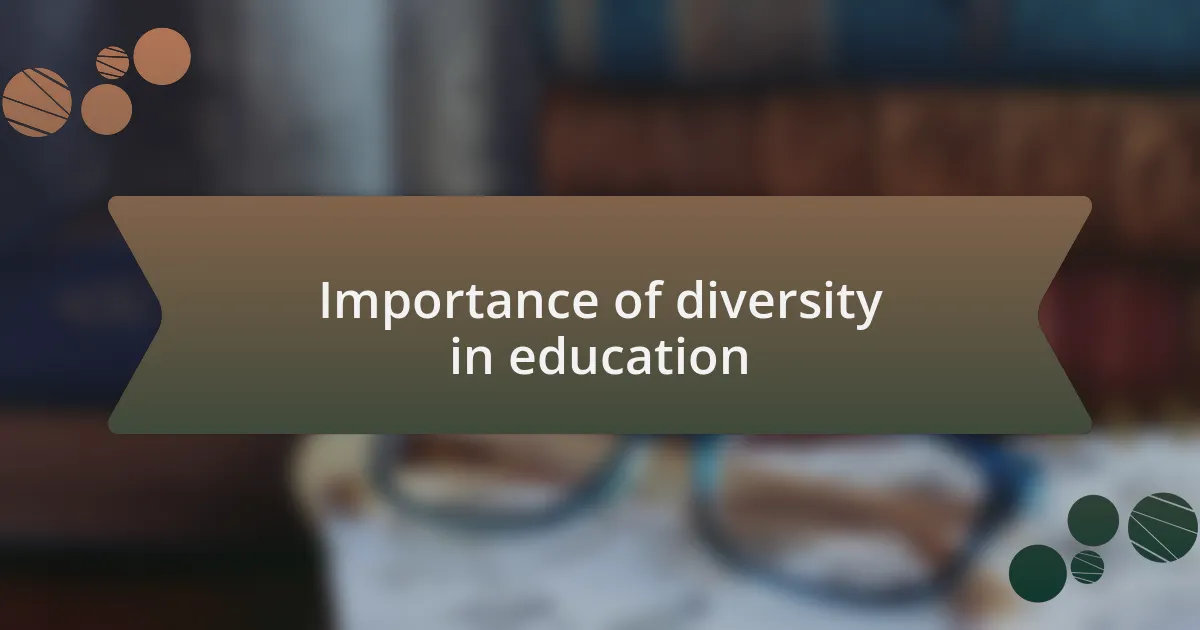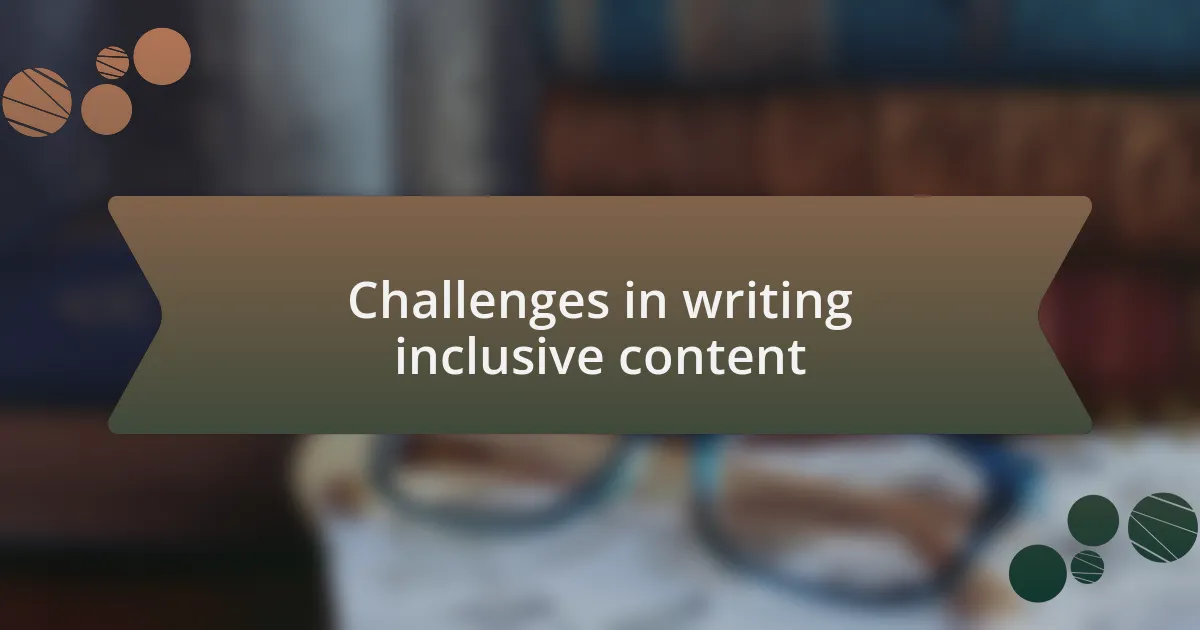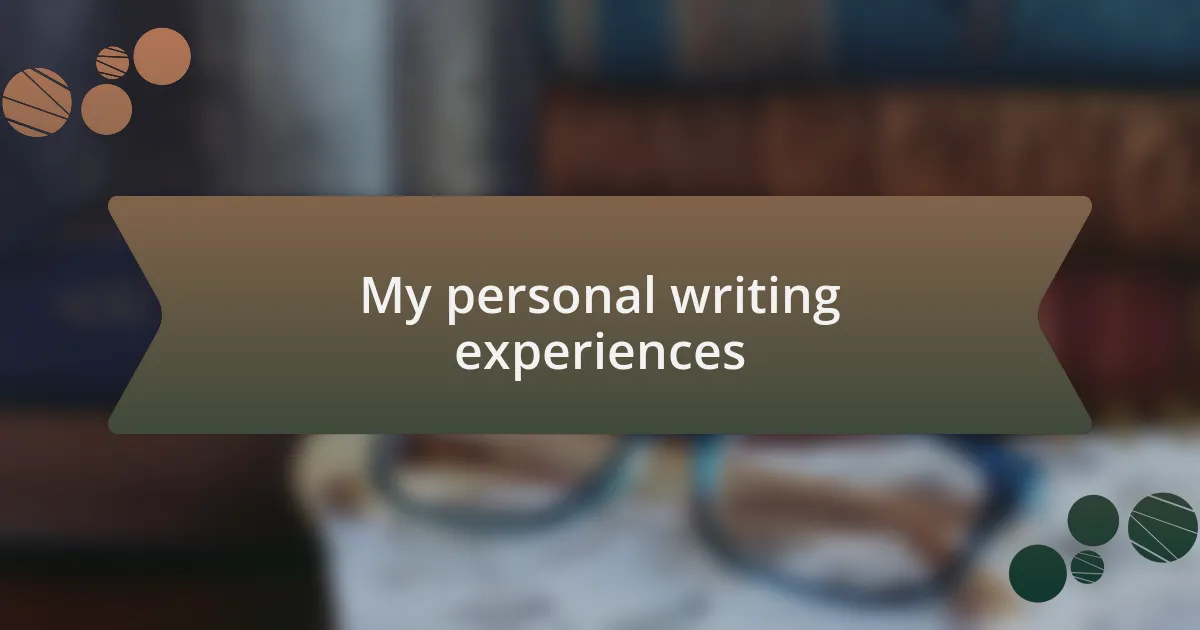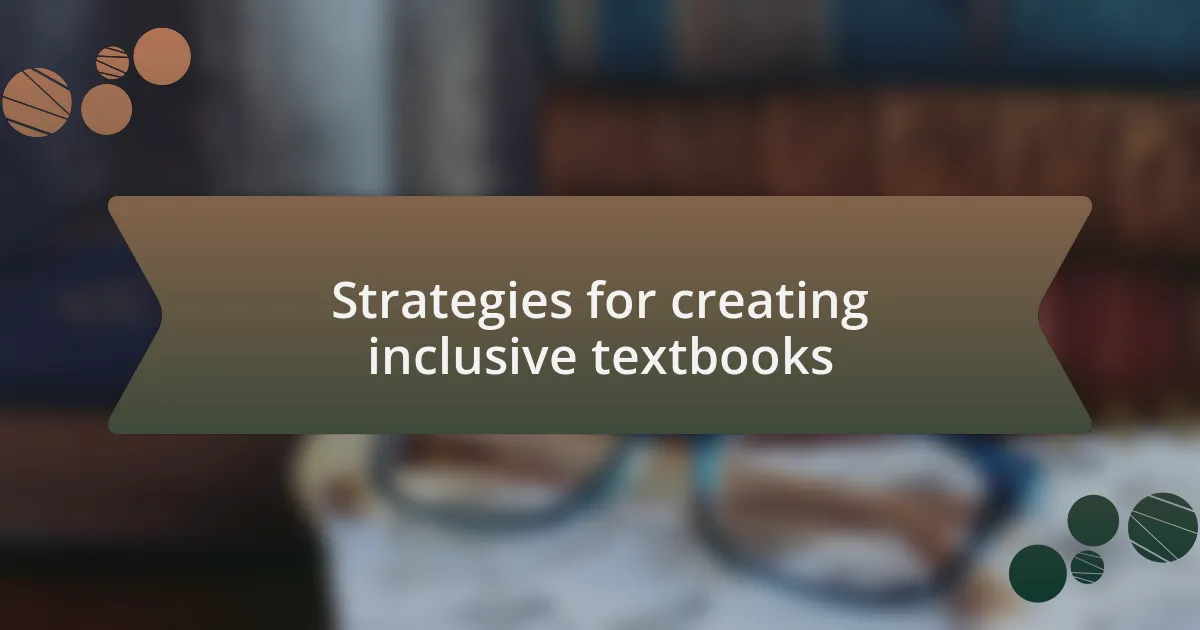Key takeaways:
- Inclusive textbooks reflect diverse identities and learning styles, fostering belonging and effective education.
- Diversity in education enriches content and prepares students for collaboration in a multicultural society.
- Challenges in writing inclusive content include avoiding stereotypes and keeping up with evolving language and societal norms.
- Collaboration and audience feedback are crucial for creating relevant and engaging inclusive educational materials.

Definition of inclusive textbooks
Inclusive textbooks are educational materials designed to reflect the diverse identities, backgrounds, and experiences of all students. I remember working on a textbook project where we strove to include stories from various cultures and perspectives. It made me realize how essential it is for students to see themselves represented in what they read; it fosters a sense of belonging and respect.
Moreover, inclusive textbooks not only cover various cultural and ethnic narratives but also address different learning styles. I often think about my own struggles with traditional textbooks that didn’t cater to visual learners like me. By integrating multimedia elements and varied formats, inclusive textbooks can engage all types of learners, paving the way for a more effective educational experience.
Finally, an inclusive textbook doesn’t shy away from discussing complex societal issues, promoting critical thinking and empathy. Have you ever found yourself learning something profound from a book that challenged your viewpoint? Creating materials that invite such reflection can empower students to think critically about the world around them, fostering a generation of informed and compassionate thinkers.

Importance of diversity in education
Diversity in education is crucial because it helps students appreciate a wide range of perspectives. I recall a moment in my own schooling when a teacher introduced us to authors from different backgrounds. That simple act opened my eyes to experiences I had never considered. It was enlightening to see how narratives can shape our understanding of each other and the world.
When we incorporate diverse cultures and identities into educational materials, we prepare students for a multicultural society. I often reflect on how today’s workforce demands collaboration among individuals from various backgrounds. By embracing diversity in textbooks, we not only enrich the content but also equip students with the skills to navigate and thrive in an increasingly interconnected world.
Additionally, inclusive education fosters empathy and compassion among students. Have you ever noticed how stories about others’ struggles can evoke strong feelings? I certainly have. When students learn about different experiences, they tend to develop a deeper understanding, which can reduce prejudice and inspire positive social change. This emotional connection is vital for creating a more harmonious and accepting environment.

Key elements of inclusive writing
When thinking about the key elements of inclusive writing, it’s essential to prioritize language that is respectful and affirming of all identities. During my early writing experiences, I stumbled upon the profound impact that simple word choices could have. For instance, replacing “he/she” with “they” not only reflects inclusivity but also embraces the diversity of gender identities. Have you ever noticed how a small change in language can make someone feel seen and valued?
Another vital element is the use of diverse examples and case studies that reflect a wide range of experiences. I remember when I was tasked with creating a curriculum that highlighted the achievements of individuals from various backgrounds. It was a challenge, but the joy of uncovering stories that resonated with my students was immensely rewarding. Short stories or anecdotes can serve as powerful tools to connect with learners—doesn’t hearing someone’s journey allow you to relate on a deeper level?
Moreover, an inclusive writing approach also means ensuring accessibility. This includes using plain language and providing definitions for complex terms. I often faced situations where my students were disengaged due to the dense academic jargon in textbooks. By simplifying language, not only did I capture their interest, but I also empowered them to feel confident in their abilities to engage with the material. Can you imagine how much more inclusive our educational spaces would be if everyone could understand and participate fully?

Challenges in writing inclusive content
Writing inclusive content brings a unique set of challenges that every educator or publisher can relate to. One significant hurdle I faced was the fear of inadvertently perpetuating stereotypes or excluding certain groups. I vividly recall a discussion with colleagues about representation in a textbook. We were passionate about our intentions, yet we found ourselves debating what truly constitutes diverse perspectives. Have you ever found yourself wrestling with the nuances of language? That confusion often leads to hesitation, making it difficult to strike the right tone.
Another challenge is the ever-evolving nature of language and societal norms. As I worked on various projects, I learned how quickly terminology can change, often leaving me worried about using outdated descriptors. I remember revising a set of materials just weeks after they had been approved because new conversations around identity emerged. It made me realize: how can we keep our content relevant and inclusive in a world that changes so rapidly? This is an ongoing learning journey where I contribute as much as I learn from my community of readers and peers.
Moreover, balancing inclusivity with clarity sometimes feels like walking a tightrope. During my time developing educational resources, I’ve struggled to ensure that my writing resonates with all students while maintaining the core message. For instance, I experimented with incorporating real-life examples that highlighted diversity but worried they might complicate the main point. How do we ensure that our efforts to be inclusive enhance understanding rather than detract from it? Finding that balance often requires rigorous self-reflection and feedback from those who engage with the material.

My personal writing experiences
When I first ventured into writing inclusive textbooks, I was filled with both excitement and self-doubt. One memorable experience was while crafting a chapter on historical figures from diverse backgrounds. I wanted to portray their stories authentically. However, I often questioned whether my perspective would do justice to their legacies. It taught me that vulnerability can be a powerful tool in writing; by acknowledging my limitations, I could invite richer discussions and feedback.
As I delved deeper into the writing process, I began to appreciate the importance of collaboration. I remember a specific project where I reached out to educators from various cultural backgrounds to review my drafts. Their insights were invaluable, illuminating areas where I had unintentionally overlooked representation. This experience reinforced my belief that inclusivity thrives in dialogue. Have you ever sought feedback that transformed your ideas? I found that open conversations significantly enriched my work.
Another significant turning point for me was realizing how emotional the writing process can be. I often felt a deep sense of responsibility to ensure every student felt seen and valued in my texts. There were moments when I poured my heart into crafting a passage, only to receive critiques that challenged my approach. It stung, but ultimately those moments became catalysts for growth. How can we evolve if we don’t embrace constructive criticism? This question shaped my journey, pushing me to refine my voice and commitment to inclusivity.

Strategies for creating inclusive textbooks
Creating inclusive textbooks requires intentional strategies that acknowledge the diversity of student experiences. One effective approach I discovered was to integrate diverse narratives seamlessly into the content. For instance, when I was writing a chapter on environmental science, I included case studies from Indigenous communities. This not only highlighted their unique perspectives but also affirmed the idea that science is enriched by multiple viewpoints. How often do we think about whose stories are being told in our textbooks?
Another strategy that proved beneficial was developing clear guidelines for language and imagery. During one project, I found myself reviewing illustrations that unwittingly reinforced stereotypes. It was a pivotal moment; I realized the power visuals hold in shaping perceptions. I consulted with graphic designers and educators focused on equity to ensure every image represented diverse identities positively. This collaborative method transformed my understanding of inclusivity in design—what have you learned from collaboration?
Finally, I learned the importance of collecting feedback from a wider audience during the writing process. I remember hosting a workshop with students representing various backgrounds to discuss a draft. Their candid responses and perspectives brought to light aspects I’d never considered. It reaffirmed my belief that involving the audience in the creation process is crucial. After all, who better to guide us in producing inclusive content than the very readers we aim to serve?

Future of inclusive educational publishing
The future of inclusive educational publishing looks promising as technology continues to evolve. I vividly recall experimenting with interactive e-books for a project, where students engaged with the material in real-time. This not only made learning more dynamic but allowed for a personalized experience that catered to various learning styles. Have you experienced the impact of technology on education?
As we move forward, I believe that collaboration will be key. Recently, I participated in a consortium of educators and authors aimed at redefining curriculum standards. Our discussions revealed a shared passion for creating materials that reflect diverse cultures and experiences. It was empowering to see our joint effort translate into textbooks that resonate more deeply with students. How often do we recognize that collective input shapes the very resources we use?
Moreover, I foresee a vital shift towards continuous feedback loops involving students, parents, and educators. In my past projects, I sought input not just at the end, but throughout the writing process. This made the content more relevant and engaging. Imagine a publishing landscape where feedback isn’t just a box ticked but is embedded in every iteration—how transformative would that be for learning?